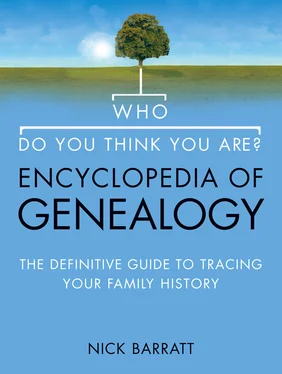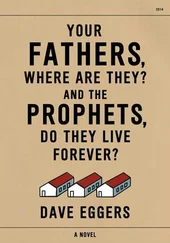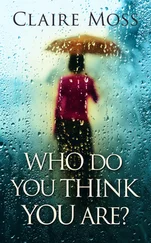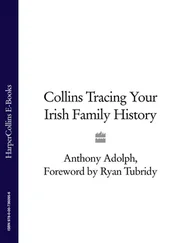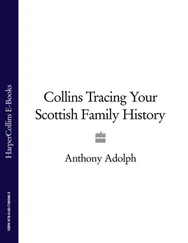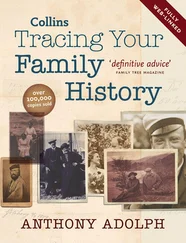Census Returns
Along with civil registration certificates, census returns are the other vital genealogical source for tracing people in the nineteenth century. Since they cover an entire household at a time, they enable you to extend and broaden your family tree to include the extended family. This chapter will explain what census records are, what they contain, how to find them and extract their information, and various ways of using this data to start other lines of research.
Although there had been sporadic population surveys at various times in this country (such as the Domesday Book, commissioned in the late eleventh century by William the Conqueror), it was not until the introduction of the census in the early nineteenth century that collecting detailed information about the size and nature of the country’s population became a regular event. Censuses are of vital importance to a genealogist because they provide snapshots of entire families at a particular moment in time, linking relatives and different generations together in the same household as well as providing information about where they lived, their social status and their line of work.
The first census was conducted for England, Wales, the Isle of Man, the Channel Islands and Scotland in 1801 and there have been censuses conducted every 10 years since that date (except in 1941 due to the Second World War). Censuses started in Ireland a bit later, from 1821. The decision to collect the information followed much debate and controversy in Parliament, as many people feared the process could infringe individual freedoms and liberties. The surveys were not intended for family history purposes and their usefulness in this sphere was realized only later.
‘Censuses provide snapshots of entire families at a particular moment in time.’
The censuses for 1801 to 1831 were simple headcounts, which were used to produce accurate population figures and trends for the country. Indeed, the census for 1801 was primarily conducted in response to the threat of invasion during the Napoleonic Wars as an attempt by the government to ascertain how many potential soldiers would be available for conscription. Interestingly, however, the census returns for 1821 and 1831 for a very small minority of places contain more detailed information other than simple headcounts, with the names of the head of each household included, as happened in Hackney, London, for example. This was for no other reason than the enthusiasm of the people who went round collecting the information – little-known men such as Richard Stopher, who lived in the Suffolk village of Saxmundham most of his life and added notes to his census returns based on his local knowledge of the village’s occupants.
In 1840 the responsibility for collecting census information became part of the remit of the General Register Office (GRO) and subsequent censuses contain more details. From 1841 the censuses started listing the names of everyone in each household, and after 1851 even more detailed information was provided, including exact place of birth (providing researchers with the vital clue to trace these people further back in time). For reasons of privacy, censuses are not released into the public domain for 100 years. Hence, it is currently possible to view all returns only up until 1901.
The census for 1911 was released to the public in its entirety on 3 January 2012. However, due to the passing of the Freedom of Information Act (2000), the Information Commissioner ruled in 2006 that people were entitled to view parts of the census information now upon request. Currently The National Archives (TNA) holds all census returns, and will answer specific requests relating to particular addresses (it is not possible to do a name search) using its paid research service. TNA also hopes to offer a comprehensive searchable service for the census from 2009 onwards. However, this will exclude certain personal information (such as mental deficiencies or handicaps) until 2012.
Ireland has also released its censuses for 1901 and 1911. Unfortunately, however, no full censuses exist for Ireland prior to 1901 as they were destroyed in 1922 by a fire in the General Register Office in Dublin during the Irish Civil War. Those wishing to trace their Irish ancestors will have to rely on other sources for the nineteenth century, such as the Griffiths’ Valuation.
How Census Information was Collected
Censuses record all residents living in a particular property on one specific night (which varied depending on which census is being viewed – see below). A week or sometimes a couple of days prior to the given date, census enumerators would deliver census forms to each household within their enumeration district. The head of the household was obliged to fill in the required information as accurately as possible and the enumerator would then collect the forms the day after census night. As illiteracy levels were high in the nineteenth century, the enumerator would often assist the head of the household in filling out the forms.
Making the Most of Census Returns
Most census returns show us the names of everybody in a household, usually including how they are related to one another, their ages, occupations, places of birth and where they lived. Combining this material with that of civil registration certificates and parish registers gives you a fuller picture of your family’s background, so that you can see how their occupations changed over time, how they migrated around the country, as well as giving you a better idea of how each generation interacted as a family. You might want to use the information gathered from these sources to locate the addresses where your ancestors lived and see if their houses still stand.
The data found on census returns can be used to narrow down searches using other records:
1.If you know from your great-grandfather’s birth certificate that his parents must have married before 1899, you can immediately reduce the number of years you have to search for their marriage if you find the family on the 1901 census and work out that their eldest child was born around 1892. You can then start searching for their marriage back from 1892 rather than 1899.
2.Deaths can also be traced with the help of census returns. If you find a couple living together on one census but on a census return taken ten years later one spouse is missing and the other is listed as a widow or widower, you will know to conduct a ten-year death search for that period.
3.Use the details given on the census returns to corroborate information found on certificates. Check the addresses, ages and relationships on the returns to see if they match those given on civil registration certificates of a similar date. Equally, if you find part of your family living in a particular town on the census returns, you should find out what civil registration district that town was covered by so that you can look out for that place when locating those ancestors in the birth, marriage and death indexes.
The next step would be for the enumerator to use these ‘schedules’ and transfer the gathered information into his ‘enumerator’s book’. He would also record which houses lay uninhabited within his district. These completed books would be checked by a supervisor and then sent to London to allow the statisticians to compile the information they wished. It is these enumeration books that form the census records now available for the general public to view. Unfortunately, the original forms completed by each household were destroyed.
As the records are handwritten, the returns often have the enumerator’s notes alongside the entries, sometimes obscuring the actual information. An important notation to bear in mind is the practice of separating each household by slashes on the top left corner of the head of the household’s name. A single slash on top of the name would indicate a separate household within the same property and a double slash separate households in different properties. These slashes are particularly useful when individual house numbers have not been noted.
Читать дальше
